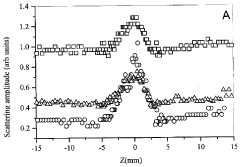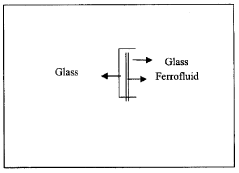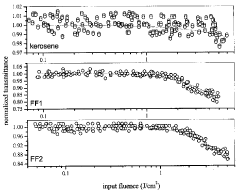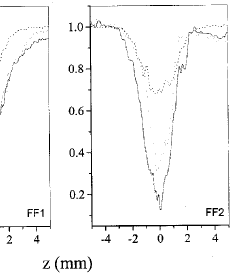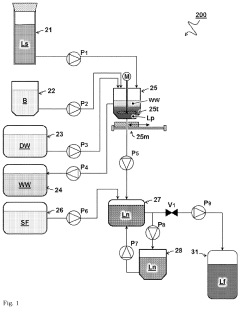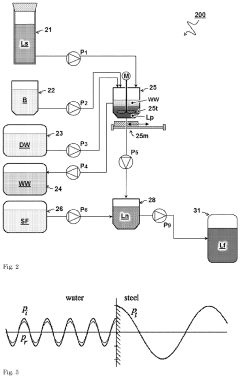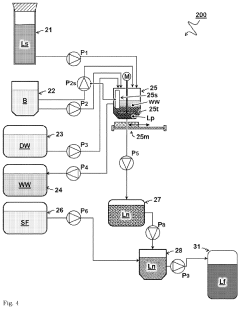The Role of Ferrofluid in Advanced Chemical Processing Techniques
JUL 9, 20259 MIN READ
Generate Your Research Report Instantly with AI Agent
Patsnap Eureka helps you evaluate technical feasibility & market potential.
Ferrofluid Evolution and Objectives
Ferrofluids, first developed in the 1960s by NASA, have evolved significantly over the past six decades. These unique liquids, composed of nanoscale ferromagnetic particles suspended in a carrier fluid, have transitioned from a space-age curiosity to a versatile tool in advanced chemical processing techniques. The evolution of ferrofluids has been marked by continuous improvements in their stability, magnetic responsiveness, and adaptability to various chemical environments.
Initially, ferrofluids were primarily used in mechanical applications, such as seals and dampers. However, as research progressed, their potential in chemical processing became increasingly apparent. The ability to manipulate ferrofluids using external magnetic fields opened up new possibilities for precise control of fluid dynamics at the microscale, a crucial factor in many chemical processes.
The objectives of ferrofluid technology in advanced chemical processing have expanded significantly. One primary goal is to enhance mixing and separation processes in complex chemical systems. By leveraging the magnetic properties of ferrofluids, researchers aim to create more efficient and controllable mixing mechanisms, particularly in microfluidic devices. This has implications for improving reaction rates and yields in various chemical syntheses.
Another key objective is to develop novel heat transfer systems. Ferrofluids' unique thermomagnetic properties make them excellent candidates for advanced cooling solutions in chemical reactors and other high-temperature processing equipment. The ability to direct and control heat flow using magnetic fields offers the potential for more precise temperature control in sensitive chemical processes.
In the realm of catalysis, ferrofluids are being explored as a means to create magnetically recoverable catalysts. This approach aims to combine the high surface area and reactivity of nanoparticles with the ease of separation provided by magnetic properties, potentially revolutionizing catalyst recovery and reuse in industrial chemical processes.
The development of smart fluids for responsive chemical systems represents another frontier. Researchers are working on ferrofluids that can change their properties in response to external stimuli, not just magnetic fields but also pH, temperature, or light. Such smart fluids could enable adaptive chemical processing systems that automatically adjust to changing conditions.
As we look to the future, the objectives for ferrofluid technology in chemical processing are becoming increasingly ambitious. There is a growing focus on developing multifunctional ferrofluids that can simultaneously perform multiple roles in chemical processes, such as mixing, separation, and catalysis. Additionally, there is a push towards more environmentally friendly and sustainable ferrofluid formulations, aligning with broader trends in green chemistry.
Initially, ferrofluids were primarily used in mechanical applications, such as seals and dampers. However, as research progressed, their potential in chemical processing became increasingly apparent. The ability to manipulate ferrofluids using external magnetic fields opened up new possibilities for precise control of fluid dynamics at the microscale, a crucial factor in many chemical processes.
The objectives of ferrofluid technology in advanced chemical processing have expanded significantly. One primary goal is to enhance mixing and separation processes in complex chemical systems. By leveraging the magnetic properties of ferrofluids, researchers aim to create more efficient and controllable mixing mechanisms, particularly in microfluidic devices. This has implications for improving reaction rates and yields in various chemical syntheses.
Another key objective is to develop novel heat transfer systems. Ferrofluids' unique thermomagnetic properties make them excellent candidates for advanced cooling solutions in chemical reactors and other high-temperature processing equipment. The ability to direct and control heat flow using magnetic fields offers the potential for more precise temperature control in sensitive chemical processes.
In the realm of catalysis, ferrofluids are being explored as a means to create magnetically recoverable catalysts. This approach aims to combine the high surface area and reactivity of nanoparticles with the ease of separation provided by magnetic properties, potentially revolutionizing catalyst recovery and reuse in industrial chemical processes.
The development of smart fluids for responsive chemical systems represents another frontier. Researchers are working on ferrofluids that can change their properties in response to external stimuli, not just magnetic fields but also pH, temperature, or light. Such smart fluids could enable adaptive chemical processing systems that automatically adjust to changing conditions.
As we look to the future, the objectives for ferrofluid technology in chemical processing are becoming increasingly ambitious. There is a growing focus on developing multifunctional ferrofluids that can simultaneously perform multiple roles in chemical processes, such as mixing, separation, and catalysis. Additionally, there is a push towards more environmentally friendly and sustainable ferrofluid formulations, aligning with broader trends in green chemistry.
Chemical Processing Market Analysis
The chemical processing market has experienced significant growth in recent years, driven by increasing demand for specialty chemicals, pharmaceuticals, and advanced materials. The global chemical processing market was valued at $3.94 trillion in 2021 and is projected to reach $5.33 trillion by 2028, growing at a CAGR of 4.6% during the forecast period. This growth is attributed to the rising industrialization, urbanization, and technological advancements in emerging economies.
The market is segmented into various sectors, including petrochemicals, basic chemicals, specialty chemicals, and consumer chemicals. Among these, specialty chemicals have shown the highest growth potential due to their wide range of applications in industries such as electronics, automotive, and healthcare. The specialty chemicals segment is expected to grow at a CAGR of 5.8% from 2022 to 2028.
Geographically, Asia-Pacific dominates the chemical processing market, accounting for over 45% of the global market share. China, India, and Japan are the key contributors to this regional dominance. North America and Europe follow, with the United States and Germany being major players in these regions, respectively.
The introduction of advanced technologies, such as ferrofluids, in chemical processing has opened up new opportunities for market growth. Ferrofluids, with their unique magnetic properties, have found applications in various chemical processing techniques, including separation processes, heat transfer, and catalysis. The global ferrofluid market size was valued at $57.7 million in 2020 and is expected to grow at a CAGR of 5.2% from 2021 to 2028.
Key market trends in chemical processing include the adoption of sustainable and green chemistry practices, digitalization and automation of processes, and the development of bio-based chemicals. The increasing focus on environmental regulations and sustainability has led to a shift towards eco-friendly production methods and the use of renewable feedstocks.
The COVID-19 pandemic has had a mixed impact on the chemical processing market. While certain sectors, such as pharmaceuticals and personal care, experienced increased demand, others, like automotive and construction, faced significant challenges. However, the market has shown resilience and is expected to recover strongly in the post-pandemic period.
In conclusion, the chemical processing market presents substantial opportunities for growth and innovation, particularly in the realm of advanced technologies like ferrofluids. As the industry continues to evolve, companies that invest in research and development of novel processing techniques are likely to gain a competitive edge in this dynamic market landscape.
The market is segmented into various sectors, including petrochemicals, basic chemicals, specialty chemicals, and consumer chemicals. Among these, specialty chemicals have shown the highest growth potential due to their wide range of applications in industries such as electronics, automotive, and healthcare. The specialty chemicals segment is expected to grow at a CAGR of 5.8% from 2022 to 2028.
Geographically, Asia-Pacific dominates the chemical processing market, accounting for over 45% of the global market share. China, India, and Japan are the key contributors to this regional dominance. North America and Europe follow, with the United States and Germany being major players in these regions, respectively.
The introduction of advanced technologies, such as ferrofluids, in chemical processing has opened up new opportunities for market growth. Ferrofluids, with their unique magnetic properties, have found applications in various chemical processing techniques, including separation processes, heat transfer, and catalysis. The global ferrofluid market size was valued at $57.7 million in 2020 and is expected to grow at a CAGR of 5.2% from 2021 to 2028.
Key market trends in chemical processing include the adoption of sustainable and green chemistry practices, digitalization and automation of processes, and the development of bio-based chemicals. The increasing focus on environmental regulations and sustainability has led to a shift towards eco-friendly production methods and the use of renewable feedstocks.
The COVID-19 pandemic has had a mixed impact on the chemical processing market. While certain sectors, such as pharmaceuticals and personal care, experienced increased demand, others, like automotive and construction, faced significant challenges. However, the market has shown resilience and is expected to recover strongly in the post-pandemic period.
In conclusion, the chemical processing market presents substantial opportunities for growth and innovation, particularly in the realm of advanced technologies like ferrofluids. As the industry continues to evolve, companies that invest in research and development of novel processing techniques are likely to gain a competitive edge in this dynamic market landscape.
Ferrofluid Challenges in Chemical Processing
The integration of ferrofluids into chemical processing techniques presents several significant challenges that researchers and engineers must address. One of the primary obstacles is the stability of ferrofluids under various processing conditions. Ferrofluids are colloidal suspensions of magnetic nanoparticles, and maintaining their stability in diverse chemical environments, especially at high temperatures or in the presence of strong magnetic fields, remains a complex issue. The potential for particle agglomeration or separation from the carrier fluid can compromise the effectiveness of ferrofluid-based processes.
Another critical challenge lies in the precise control of ferrofluid behavior within chemical reactors. While the ability to manipulate ferrofluids using external magnetic fields offers unique advantages, achieving fine-tuned control over fluid dynamics, heat transfer, and mass transport processes is technically demanding. This becomes particularly crucial in applications such as targeted catalyst delivery or selective extraction, where precise spatial and temporal control is essential for optimal performance.
The compatibility of ferrofluids with existing chemical processing equipment and infrastructure poses additional hurdles. Many current systems are not designed to accommodate the unique properties of ferrofluids, necessitating modifications or entirely new designs. This includes considerations for materials compatibility, as ferrofluids may interact with or corrode certain components, as well as the need for specialized magnetic field generation and control systems integrated into processing units.
Scaling up ferrofluid-based chemical processes from laboratory to industrial scale presents its own set of challenges. Maintaining uniform magnetic field distribution and ferrofluid properties across larger volumes is technically complex and may require innovative engineering solutions. Additionally, ensuring consistent performance and reproducibility at scale is critical for commercial viability but remains a significant technical hurdle.
The recovery and recycling of ferrofluids in continuous chemical processes also present challenges. Efficient separation of ferrofluids from product streams, without compromising their magnetic properties or stability, is crucial for both economic and environmental reasons. Developing robust separation techniques that can operate under various process conditions without degrading the ferrofluid is an ongoing area of research and development.
Lastly, the potential environmental and safety implications of using ferrofluids in chemical processing must be carefully considered. While ferrofluids offer many advantages, their long-term environmental impact and potential risks in case of accidental release need thorough assessment. Developing safe handling protocols, containment strategies, and environmental remediation techniques specific to ferrofluids in chemical processing contexts is essential for their widespread adoption in industry.
Another critical challenge lies in the precise control of ferrofluid behavior within chemical reactors. While the ability to manipulate ferrofluids using external magnetic fields offers unique advantages, achieving fine-tuned control over fluid dynamics, heat transfer, and mass transport processes is technically demanding. This becomes particularly crucial in applications such as targeted catalyst delivery or selective extraction, where precise spatial and temporal control is essential for optimal performance.
The compatibility of ferrofluids with existing chemical processing equipment and infrastructure poses additional hurdles. Many current systems are not designed to accommodate the unique properties of ferrofluids, necessitating modifications or entirely new designs. This includes considerations for materials compatibility, as ferrofluids may interact with or corrode certain components, as well as the need for specialized magnetic field generation and control systems integrated into processing units.
Scaling up ferrofluid-based chemical processes from laboratory to industrial scale presents its own set of challenges. Maintaining uniform magnetic field distribution and ferrofluid properties across larger volumes is technically complex and may require innovative engineering solutions. Additionally, ensuring consistent performance and reproducibility at scale is critical for commercial viability but remains a significant technical hurdle.
The recovery and recycling of ferrofluids in continuous chemical processes also present challenges. Efficient separation of ferrofluids from product streams, without compromising their magnetic properties or stability, is crucial for both economic and environmental reasons. Developing robust separation techniques that can operate under various process conditions without degrading the ferrofluid is an ongoing area of research and development.
Lastly, the potential environmental and safety implications of using ferrofluids in chemical processing must be carefully considered. While ferrofluids offer many advantages, their long-term environmental impact and potential risks in case of accidental release need thorough assessment. Developing safe handling protocols, containment strategies, and environmental remediation techniques specific to ferrofluids in chemical processing contexts is essential for their widespread adoption in industry.
Current Ferrofluid Applications
01 Composition and preparation of ferrofluids
Ferrofluids are colloidal suspensions of magnetic nanoparticles in a carrier fluid. They are typically composed of magnetite or other ferromagnetic materials coated with surfactants to prevent agglomeration. The preparation process involves careful control of particle size and distribution to maintain stability and magnetic properties.- Composition and preparation of ferrofluids: Ferrofluids are colloidal suspensions of magnetic nanoparticles in a carrier fluid. They are typically composed of magnetite or other ferromagnetic materials coated with a surfactant to prevent agglomeration. The preparation process involves careful control of particle size and distribution to maintain stability and magnetic properties.
- Applications in sealing and lubrication: Ferrofluids are widely used in sealing and lubrication applications, particularly in rotating shaft seals. They provide a liquid barrier that can be controlled by magnetic fields, offering advantages in terms of low friction, long life, and the ability to operate in vacuum environments.
- Thermal management and cooling systems: Ferrofluids are employed in thermal management solutions, particularly in electronic cooling systems. Their unique properties allow for efficient heat transfer and the ability to be directed by magnetic fields, making them useful in targeted cooling applications for components like processors and power electronics.
- Sensor and actuator technologies: Ferrofluids are utilized in various sensor and actuator technologies. Their responsiveness to magnetic fields makes them suitable for applications such as accelerometers, tilt sensors, and damping systems. They can also be used in haptic feedback devices and precision positioning systems.
- Medical and biomedical applications: Ferrofluids have emerging applications in the medical and biomedical fields. They are being researched for use in targeted drug delivery, magnetic hyperthermia for cancer treatment, and as contrast agents in magnetic resonance imaging (MRI). Their ability to be manipulated by external magnetic fields offers potential for minimally invasive procedures.
02 Applications in sealing and lubrication
Ferrofluids are widely used in sealing and lubrication applications, particularly in rotating shaft seals and bearings. They provide low-friction, zero-leakage seals that can operate under high pressure differentials and in vacuum environments. These applications leverage the fluid's ability to be held in place by magnetic fields while maintaining liquid properties.Expand Specific Solutions03 Thermal management and heat transfer
Ferrofluids exhibit enhanced heat transfer properties due to their magnetic nature. They are used in cooling systems for electronic devices, speakers, and transformers. When subjected to a magnetic field, the fluid's thermal conductivity can be controlled, allowing for efficient heat dissipation in various applications.Expand Specific Solutions04 Damping and vibration control
The unique properties of ferrofluids make them excellent for damping and vibration control applications. They can be used in shock absorbers, inertial dampers, and acoustic devices. The fluid's viscosity can be controlled by applying magnetic fields, allowing for adaptive damping in various mechanical systems.Expand Specific Solutions05 Sensing and measurement applications
Ferrofluids are employed in various sensing and measurement devices. They are used in accelerometers, inclinometers, and pressure sensors. The fluid's response to magnetic fields and its ability to change shape and position make it suitable for detecting and measuring physical quantities in a wide range of applications.Expand Specific Solutions
Key Ferrofluid Industry Players
The ferrofluid market in advanced chemical processing is in a growth phase, driven by increasing applications in various industries. The market size is expanding, with projections indicating significant growth potential in the coming years. Technologically, ferrofluids are advancing rapidly, with key players like Ferrotec, Hitachi, and Applied Materials leading innovation. Universities such as Yale, Delft, and Sorbonne are contributing to fundamental research, while companies like ChemTreat and Resonac are exploring practical applications. The technology's maturity is progressing, with ongoing developments in synthesis, stability, and functionality of ferrofluids for diverse chemical processing applications.
Hitachi Ltd.
Technical Solution: Hitachi has incorporated ferrofluid technology into various chemical processing applications. They have developed a ferrofluid-based magnetic separation system for purifying industrial wastewater, capable of removing both magnetic and non-magnetic contaminants with high efficiency[8]. Hitachi's research also includes the use of ferrofluids in enhanced oil recovery techniques, where magnetically guided ferrofluids are used to improve sweep efficiency and oil displacement in reservoirs[10]. Furthermore, the company has created a ferrofluid-assisted coating process for producing uniform thin films in chemical vapor deposition applications, particularly useful in the production of advanced materials and electronics[12].
Strengths: Effective wastewater treatment solutions, improved oil recovery techniques, and precision coating processes. Weaknesses: Some applications may be energy-intensive and require careful handling of magnetic materials in industrial settings.
Ferrotec (USA) Corp.
Technical Solution: Ferrotec has developed advanced ferrofluid-based technologies for chemical processing. Their approach involves using magnetically controlled ferrofluids to enhance separation processes and catalytic reactions. The company's ferrofluid formulations are designed to act as both a carrier and a catalyst, allowing for precise control of chemical reactions at the molecular level[1]. They have implemented a novel magnetic field-assisted mixing system that utilizes ferrofluids to create highly efficient micro-reactors, significantly improving mass transfer rates in complex chemical processes[3]. Additionally, Ferrotec has pioneered the use of ferrofluid-based heat transfer systems in chemical reactors, enabling better temperature control and energy efficiency in exothermic and endothermic reactions[5].
Strengths: Precise control of chemical reactions, improved mass transfer rates, and enhanced heat management. Weaknesses: Potential for magnetic particle contamination in final products and the need for specialized equipment to handle ferrofluids.
Innovative Ferrofluid Research
Optical limiting ferromagnetic nanoparticles and device thereof
PatentInactiveIN1981CHE2007A
Innovation
- Synthesizing ferromagnetic nanoparticles of specific sizes (4-6 nm) using an optimized co-precipitation technique and incorporating them into a ferrofluid, which is then encapsulated between glass plates without air gaps for enhanced thermal stability and optical limiting performance.
ferrofluid
PatentPendingUS20220351887A1
Innovation
- A method involving a stock solution of Fe(II) and Fe(III) mixed with a base to form magnetic nanoparticles, followed by magnetic separation and washing, allowing for the production of ferrofluids in a semi-continuous and scalable process using only aqueous solutions, eliminating the need for organic solvents and high temperatures.
Environmental Impact Assessment
The integration of ferrofluid in advanced chemical processing techniques necessitates a comprehensive environmental impact assessment. Ferrofluids, composed of nanoscale magnetic particles suspended in a carrier fluid, present unique challenges and potential risks to the environment when used in industrial processes.
One primary concern is the potential release of nanoparticles into aquatic ecosystems. The small size of these particles allows them to easily penetrate biological membranes, potentially causing harm to aquatic organisms. Studies have shown that certain nanoparticles can accumulate in the tissues of fish and other aquatic life, leading to potential bioaccumulation up the food chain. This raises concerns about long-term ecological impacts and the need for stringent containment measures in ferrofluid-based chemical processing systems.
Air quality is another critical aspect to consider. While ferrofluids are typically used in closed systems, the potential for aerosolization during handling or in the event of equipment failure must be addressed. Inhalation of magnetic nanoparticles could pose respiratory risks to workers and nearby communities if proper safety protocols are not implemented.
The production and disposal of ferrofluids also warrant attention. The manufacturing process of magnetic nanoparticles often involves energy-intensive methods and the use of potentially harmful chemicals. Ensuring sustainable production practices and developing eco-friendly synthesis routes are crucial to minimizing the overall environmental footprint of ferrofluid technology.
Waste management is a significant challenge in ferrofluid applications. The disposal of spent ferrofluids must be carefully managed to prevent contamination of soil and groundwater. Recycling and recovery techniques for magnetic nanoparticles are areas of active research, aiming to reduce waste and promote circular economy principles in chemical processing industries.
On the positive side, the use of ferrofluids in chemical processing can lead to improved energy efficiency and reduced resource consumption. By enhancing heat transfer and enabling more precise control in separation processes, ferrofluid-based techniques can potentially lower the overall environmental impact of certain chemical operations. This highlights the importance of a balanced approach in assessing the environmental implications of this technology.
Regulatory frameworks and industry standards for the use of ferrofluids in chemical processing are still evolving. Developing comprehensive guidelines for handling, containment, and disposal of ferrofluids is essential to ensure environmental protection. Ongoing research into the long-term environmental fate and effects of magnetic nanoparticles will be crucial in informing these regulatory efforts and guiding sustainable implementation of ferrofluid technology in advanced chemical processing.
One primary concern is the potential release of nanoparticles into aquatic ecosystems. The small size of these particles allows them to easily penetrate biological membranes, potentially causing harm to aquatic organisms. Studies have shown that certain nanoparticles can accumulate in the tissues of fish and other aquatic life, leading to potential bioaccumulation up the food chain. This raises concerns about long-term ecological impacts and the need for stringent containment measures in ferrofluid-based chemical processing systems.
Air quality is another critical aspect to consider. While ferrofluids are typically used in closed systems, the potential for aerosolization during handling or in the event of equipment failure must be addressed. Inhalation of magnetic nanoparticles could pose respiratory risks to workers and nearby communities if proper safety protocols are not implemented.
The production and disposal of ferrofluids also warrant attention. The manufacturing process of magnetic nanoparticles often involves energy-intensive methods and the use of potentially harmful chemicals. Ensuring sustainable production practices and developing eco-friendly synthesis routes are crucial to minimizing the overall environmental footprint of ferrofluid technology.
Waste management is a significant challenge in ferrofluid applications. The disposal of spent ferrofluids must be carefully managed to prevent contamination of soil and groundwater. Recycling and recovery techniques for magnetic nanoparticles are areas of active research, aiming to reduce waste and promote circular economy principles in chemical processing industries.
On the positive side, the use of ferrofluids in chemical processing can lead to improved energy efficiency and reduced resource consumption. By enhancing heat transfer and enabling more precise control in separation processes, ferrofluid-based techniques can potentially lower the overall environmental impact of certain chemical operations. This highlights the importance of a balanced approach in assessing the environmental implications of this technology.
Regulatory frameworks and industry standards for the use of ferrofluids in chemical processing are still evolving. Developing comprehensive guidelines for handling, containment, and disposal of ferrofluids is essential to ensure environmental protection. Ongoing research into the long-term environmental fate and effects of magnetic nanoparticles will be crucial in informing these regulatory efforts and guiding sustainable implementation of ferrofluid technology in advanced chemical processing.
Scalability and Cost Analysis
The scalability and cost analysis of ferrofluid in advanced chemical processing techniques is a critical consideration for industrial applications. Ferrofluids, being colloidal suspensions of magnetic nanoparticles, offer unique properties that can enhance various chemical processes. However, their widespread adoption hinges on the ability to scale up production and maintain cost-effectiveness.
In terms of scalability, ferrofluid production has shown promising potential for large-scale manufacturing. The synthesis of magnetic nanoparticles, a key component of ferrofluids, can be achieved through various methods such as co-precipitation, thermal decomposition, and microemulsion. These methods have been successfully scaled up in industrial settings, with co-precipitation being particularly favored due to its simplicity and cost-effectiveness.
The scalability of ferrofluid applications in chemical processing is also noteworthy. Ferrofluids have been effectively used in separation processes, catalysis, and heat transfer applications at varying scales. For instance, in magnetic separation techniques, ferrofluid-based systems have been scaled up to handle large volumes of industrial effluents, demonstrating their potential for widespread implementation.
Cost analysis of ferrofluid integration in chemical processing reveals both challenges and opportunities. The primary cost drivers include the raw materials for nanoparticle synthesis, surfactants for stabilization, and the specialized equipment required for production and handling. While the initial investment for ferrofluid-based systems may be higher compared to conventional alternatives, the long-term operational costs can be significantly lower due to improved process efficiency and reduced energy consumption.
The cost-effectiveness of ferrofluids is particularly evident in specific applications. For example, in enhanced oil recovery, the use of ferrofluids has shown to increase oil yield by up to 20%, potentially offsetting the initial investment costs. Similarly, in heat transfer applications, the superior thermal conductivity of ferrofluids can lead to substantial energy savings over time.
However, challenges remain in further reducing production costs to make ferrofluids more competitive across a broader range of applications. Research efforts are focused on developing more efficient synthesis methods, exploring alternative raw materials, and optimizing formulations to reduce the overall cost while maintaining performance.
As the technology matures and production scales up, economies of scale are expected to drive down costs further. Additionally, advancements in nanoparticle synthesis and ferrofluid formulation are likely to improve the stability and performance of ferrofluids, potentially expanding their applicability and value proposition in chemical processing industries.
In terms of scalability, ferrofluid production has shown promising potential for large-scale manufacturing. The synthesis of magnetic nanoparticles, a key component of ferrofluids, can be achieved through various methods such as co-precipitation, thermal decomposition, and microemulsion. These methods have been successfully scaled up in industrial settings, with co-precipitation being particularly favored due to its simplicity and cost-effectiveness.
The scalability of ferrofluid applications in chemical processing is also noteworthy. Ferrofluids have been effectively used in separation processes, catalysis, and heat transfer applications at varying scales. For instance, in magnetic separation techniques, ferrofluid-based systems have been scaled up to handle large volumes of industrial effluents, demonstrating their potential for widespread implementation.
Cost analysis of ferrofluid integration in chemical processing reveals both challenges and opportunities. The primary cost drivers include the raw materials for nanoparticle synthesis, surfactants for stabilization, and the specialized equipment required for production and handling. While the initial investment for ferrofluid-based systems may be higher compared to conventional alternatives, the long-term operational costs can be significantly lower due to improved process efficiency and reduced energy consumption.
The cost-effectiveness of ferrofluids is particularly evident in specific applications. For example, in enhanced oil recovery, the use of ferrofluids has shown to increase oil yield by up to 20%, potentially offsetting the initial investment costs. Similarly, in heat transfer applications, the superior thermal conductivity of ferrofluids can lead to substantial energy savings over time.
However, challenges remain in further reducing production costs to make ferrofluids more competitive across a broader range of applications. Research efforts are focused on developing more efficient synthesis methods, exploring alternative raw materials, and optimizing formulations to reduce the overall cost while maintaining performance.
As the technology matures and production scales up, economies of scale are expected to drive down costs further. Additionally, advancements in nanoparticle synthesis and ferrofluid formulation are likely to improve the stability and performance of ferrofluids, potentially expanding their applicability and value proposition in chemical processing industries.
Unlock deeper insights with Patsnap Eureka Quick Research — get a full tech report to explore trends and direct your research. Try now!
Generate Your Research Report Instantly with AI Agent
Supercharge your innovation with Patsnap Eureka AI Agent Platform!
